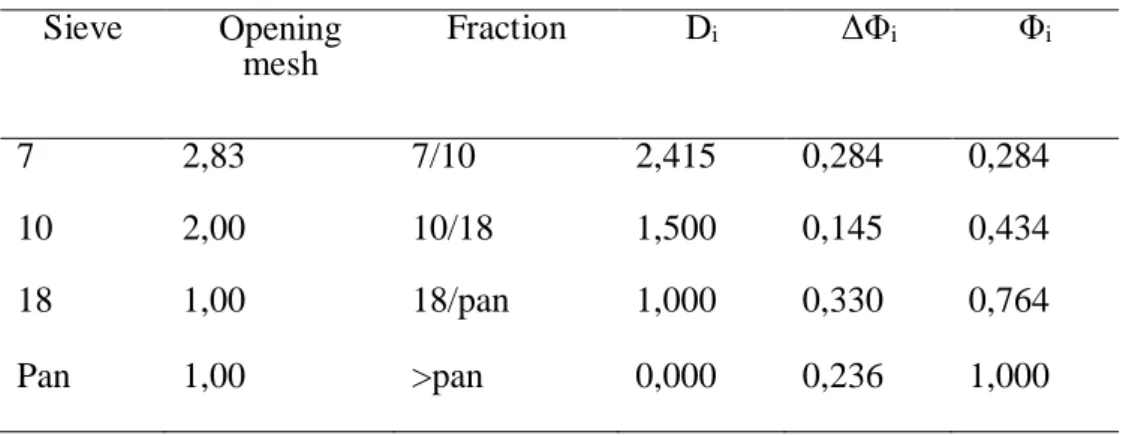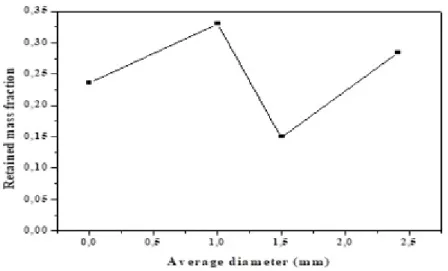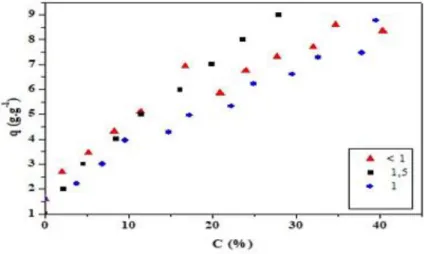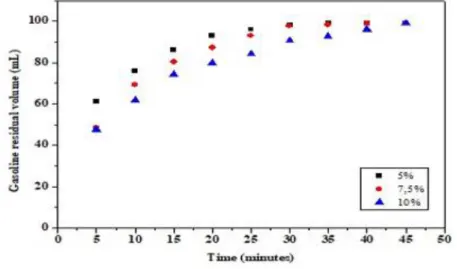Study of influence of granulometry of cactus pear forage (Opuntia fícus) bark
biomass on removal of organic contaminants in water bodies by differential
bed adsorption technique
Estudo da influência da granulometria da biomassa da casca da palma
forrageira (Opuntia fícus) na remoção de contaminantes orgânicos em corpos
d'água por técnica de adsorção diferencial em leito
DOI:10.34117/bjdv6n10-407
Recebimento dos originais: 20/09/2020 Aceitação para publicação: 20/10/2020
Lenilde Mérgia Ribeiro Lima Doutora
Universidade federal de campina grande
Rua Luiz Grande, s/n - Bairro Frei Damião – CEP: 58540-000 – Sumé-PB – Brasil Email: lenilde.mergia@professor.ufcg.edu.br
Rainy Alves Sousa Graduanda
Universidade federal de campina grande
Rua Luiz Grande, s/n - Bairro Frei Damião – CEP: 58540-000 – Sumé-PB – Brasil Email: rainy_sousa@hotmail.com
Tácia Alves de Albuquerque Graduanda
Universidade federal de campina grande
Rua Luiz Grande, s/n - Bairro Frei Damião – CEP: 58540-000 – Sumé-PB – Brasil Email: alvestacia@gmail.com
Isadora Guedes Farias Graduanda
Universidade federal de campina grande
Rua Luiz Grande, s/n - Bairro Frei Damião – CEP: 58540-000 – Sumé-PB – Brasil Email: isadoragfarias@gmail.com
Lígia Maria Ribeiro Lima Doutora
Universidade estadual de campina grande
Rua Juvêncio Arruda, s/n – Campus Universitário – Bodocongó – CEP: 58109-790 – Campina Grande-PB – Brasil
Email: ligiauepb@gmail.com ABSTRACT
Petroleum exploration oil has caused accidents that end up contaminating environment. Adsorption process has been shown to be an effective and economical method in treatment of effluents with organic compounds. Use of biomass as adsorbent has been a potentially and economical alternative for treatment of various types of effluents. Therefore, objective of this work was to study influence
bark (Opuntia fícus), typical species of northeastern semiarid, to remove gasoline in water bodies. Methodology used was proposed by Lima et al. (2014). Initially, biomass was prepared in particulate form in three different particle sizes (meshs 07, 10 and 18). Subsequently, experiments were performed to study adsorption kinetics, in which times from 05 to 60 minutes were evaluated and adsorption equilibrium, whose contaminant concentrations ranged from 5 to 60%. For differential bed, concentrations of 5%, 7.5% and 10% were used. Results confirmed that gasoline adsorption kinetics by biomass was fast in all granulometries, but its influence was not significant. Equilibrium isotherms also showed maximum adsorption capacity values close to each other for three particle sizes. In differential bed system, three different particle sizes presented significant adsorption capacity, and particle size, smaller than 1 mm resulted in higher contaminant adsorption. From results, it can be confirmed that cactus pear forage bark presents as an adsorbent biomass for removal gasoline present in water bodies and that small grain size variations do not significantly affect adsorption process.
Keywords: Gasoline, cactus pear forage, differential bed, granulometry, adsorption RESUMO
A exploração de petróleo tem causado acidentes que acabam contaminando o meio ambiente. O processo de adsorção tem se mostrado um método eficaz e econômico no tratamento de efluentes com compostos orgânicos. O uso de biomassa como adsorvente tem se mostrado uma alternativa potencialmente econômica para o tratamento de diversos tipos de efluentes. Portanto, o objetivo deste trabalho foi estudar a influência da granulometria da biomassa no processo de adsorção diferencial em leito, utilizando como biossorvente a casca forrageira da palma forrageira (Opuntia fícus), espécie típica do semiárido nordestino, para remoção de gasolina em corpos d'água. A metodologia utilizada foi proposta por Lima et al. (2014). Inicialmente, a biomassa foi preparada na forma particulada em três diferentes tamanhos de partículas (malhas 07, 10 e 18). Posteriormente, foram realizados experimentos para estudar a cinética de adsorção, nos quais foram avaliados os tempos de 05 a 60 minutos e o equilíbrio de adsorção, cujas concentrações do contaminante variaram de 5 a 60%. Para leito diferencial, foram utilizadas concentrações de 5%, 7,5% e 10%. Os resultados confirmaram que a cinética de adsorção da gasolina pela biomassa foi rápida em todas as granulometrias, mas sua influência não foi significativa. As isotermas de equilíbrio também mostraram valores de capacidade máxima de adsorção próximos uns dos outros para três tamanhos de partícula. No sistema de leito diferencial, três diferentes tamanhos de partícula apresentaram capacidade de adsorção significativa, e o tamanho de partícula menor que 1 mm resultou em maior adsorção de contaminante. A partir dos resultados, pode-se confirmar que a casca da forragem da palma forrageira apresenta-se como biomassa adsorvente para remoção da gasolina presente em corpos d'água e que pequenas variações no tamanho do grão não afetam significativamente o processo de adsorção.
Palavras-chave: Gasolina, forragem de palma forrageira, leito diferencial, granulometria, adsorção
1 INTRODUCTION
Due to rapid economic development and intense industrial and commercial activity, environment has been constantly harmed, mainly by water pollution from petroleum-derived hydrocarbons (PEREIRA; FREIRE, 2005) (TIBURTIUS; ZAMORA, 2004).
According to Costa et al. (2010), in recent years society's concern about preserving environment has greatly increased. Water pollution caused by neglect in treatment of its tailings or
by increasingly frequent accidents, which end up throwing many pollutants into aquatic environments is a matter of concern, being essential survey of quality conditions and treatment of industrial effluents(SOUZA; LIMA; SILVA, 2011).
Petroleum industry is one of most important sources of energy and environmental pollution. Petroleum is composed of complex mixtures of hydrocarbons of various molecular weights and structures ranging from a light gas (methane) to a heavy solid (ALEIXO; TACHIBANA; CASAGRANDE, 2007).
Some of hydrocarbons that most contribute to pollution of aquifers are those that make up gasoline disposed of in water bodies.
Due to these environmental implications, new technologies have been researched for degradation or immobilization of these compounds. Thus, development of alternative wastewater treatment methods that combine ever-lower rates of toxic substances and low cost is of utmost importance (PERIN et al., 2006).
Adsorption process has been shown to be an effective and economical method in treatment of effluents with organic pollutants, being necessary to search for low cost materials to be used industrially. Success of adsorption as a separation process depends on the choice of adsorbent material and optimization of process variables (LIMA, 2010). Materials used in adsorption of organic pollutants are diverse and can be minerals, synthetic organics and natural organics of animal or vegetable origin (RIBEIRO; GROSSI; AMARAL; RUBIO, 2000).
Many agricultural wastes and different biomasses have been applied as adsorbents, evaluating the performance of the adsorption process as coffee powder, eggshells and limestone peel (CARNEIRO et al., 2019).
Adsorption is based on principle that a solid surface, in contact with a fluid, tends to accumulate a surface layer of solute molecules due to imbalance of existing surface forces. Adsorption phenomenon is closely linked to the surface tension of solutions and its intensity depends on temperature, nature and concentration of adsorbed substance (adsorbate), nature and state of aggregation of adsorbent (finely divided solid) and fluid in contact with adsorbent (CAMPOS et al., 2012). Generally these solids have porous particles and larger their outer surface more favorable for adsorption (RUTHVEN, 1984).
Differential bed adsorption system is a recent technique, which consists in removing contaminants from an effluent by means of a thin layer of biosorbents in contact with effluent proposed by (SOUZA; LIMA; SILVA, 2011), illustrated in Figure 1.
Fig. 1. Representative scheme of differential bed.
When it comes to northeastern semiarid, there is a variety of biomass that can be obtained from its typical vegetation (WANDERLEY et al., 2002). Among varieties found in Paraiba's semiarid, cactus pear forage (Opuntia ficus) is a biomass alternative for use as an adsorbent of hydrogen carbon contaminants in water bodies.
Among alternatives for water decontamination through adsorption, using Differential Bed Adsorption Process (SOUZA; LIMA; SILVA, 2011) in purification of water bodies using biomass from native plants of Northeast region as adsorbent.
Thus, combination of available biomass and low cost adsorption process may be of great importance to Paraíba's cariri population.
Due to irregular distribution of rainfall in the northeastern semi-arid region, caatinga is an important forage resource. A great potential existing in region is cactus pear forage, which, due to its morphophysiological characteristics, is a plant adapted to conditions of semi-arid. Its chemical composition varies according to species and time of year (WANDERLEY et al., 2002).
It is estimated that today there are about 500 thousand hectares of forage palm in the Northeast, with much of this amount concentrated in states of Pernambuco, Paraíba, Alagoas, Rio Grande do Norte and Bahia. In Brazil, two cactus pear forage species have grown on a large scale: Opuntia fícus e Nopalea cochenillifera (WANDERLEY et al., 2002).
The fact that cactus pear forage is a plant easily found in semi-arid regions makes it a species of interest in research where an easy to acquire and persistent biomass is needed even in times of severe drought, as confirmed by Lima et al., 2019.
1.1 GRANULOMETRIC ANALYSIS
Granulometric analysis can be defined as particle size distribution of a given aggregate and is usually expressed in terms of accumulated percentages of retained or passing fractions in a given series of sieve openings, or of percentages between certain openings intervals (WEIDMANN, 2008).
Contaminant Contaminant
Effluent Effluent
According to Levine, Tchobanoglous and Asano (1985), adsorption processes is influenced by particle size distribution, so that in solid-liquid separation operations or processes, knowledge of particle size distribution can contribute to choice and refinement of treatment technologies and to adoption of appropriate operating procedures.
Thus, testing different particle size of adsorbent biomasses in adsorption processes is important in order to determine optimal particle size to increase contaminant removal efficiency.
2 MATERIALS AND METHODS
Methodology used followed procedure performed by Lima et al. (2014), which used mandacaru (Cereus jamacaruna) in particulate form to remove gasoline/diesel oil mixture using adsorption process.
First stage of research consisted of preparation of biomass in particulate form. Cactus pear forage rackets were peeled and barks were subjected to natural drying. After drying, barks were ground with aid of mortar to obtain biomass in smaller pieces. Subsequently, for homogenization of particle size were used sieves with orifice diameter of 2.83; 2.00 and 1 mm with aid of a vibrating base. To study influence of particle size, samples with a mean diameter of 1.5 and 1 mm and a diameter smaller than 1 mm were obtained.
In second stage, experiments were performed to adsorption kinetics studies, in which 12 Erlenmeyer flasks were used, containing 40 mL of water and 12 mL of gasoline and placed on a shaker table, under agitation at 130 rpm, with variation in 5 to 60 minutes at intervals of 5 minute, with 1.2 g of biosorbent added to solution.
After each stirring time, samples were subjected to filtration using a standard sieve so that particulate cactus pear forage remained retained in the filter medium, while liquid phase flowed. Then, with aid of 50 and 100 mL graduated cylinder, a volumetric analysis of sample was performed at the end of contact time between adsorbent and adsorbate, in order to determine volume of adsorbed gasoline.
For equilibrium study, which consisted of third stage of work, adsorption isotherms were obtained. Experiments were carried out on a shaking table at 130 rpm, in which 12 erlenmeyer flasks containing a fixed amount of 1.2 grams of particulate biomass and water contaminated with gasoline were placed, varying initial concentration from 5 to 60% contaminant, with a 5% variation. Subsequently, pollutants and water measurements were performed using measuring cylinders of 50 and 100 mL. Erlenmeyers flasks were stirred for 60 minutes on a shaker table and then each sample was filtered for final contaminant concentration.
Differential bed adsorption process was initiated by addition of 4000 mL (4 L) of heterogeneous gasoline/water mixture to rectangular glass container, according to methodology developed by [15].
Subsequently, powdered cactus pear forage was added to aluminum screen and thus superimposed in differential bed, so that biomass and gasoline/water mixture were in direct contact, remaining for established contact times (Figure 5 ). At the end of contact times, aluminum net system was removed to separate liquid phase from biomass and thus analyzed adsorbed amount of gasoline adsorbent in relation to adsorbate by volumetric analysis with measuring cylinder.
Experiments were performed in triplicate, with gasoline percentages of 5%, 7.5% and 10%. 3 RESULTS AND DISCUSSION
From data obtained in experiments, which were performed considering three different granulometry, kinetics and adsorption equilibrium curves were constructed, as well as for differential bed, in order to evaluate influence of biomass granulometry in adsorption process.
3.1 BIOMASS CARACTERIZATION
Biomass characterization was performed with aid of Tyler series sieves in three different particle sizes (meshs 07, 10 and 18) using a vibrating table.
Table 1 presents results of retained fractions (Δϕi) and retained cumulative fraction (ϕi) of sample in sieves. Total mass of biomass that underwent screening process was 1185.48 grams.
Table 1. Biomass characterization in different grain sizes.
In addition, for differential particle size analysis, relationship between retained fractions and sieve average diameters was constructed, as shown in Figure 2.
Sieve Opening mesh Fraction Di ΔΦi Φi 7 2,83 7/10 2,415 0,284 0,284 10 2,00 10/18 1,500 0,145 0,434 18 1,00 18/pan 1,000 0,330 0,764 Pan 1,00 >pan 0,000 0,236 1,000
Fig. 2. Differential particle size analysis of cactus pear forage biomass.
As can be seen in Figure 2, average diameters equal to 2.415 and 1.0 mm obtained largest retained fractions of biomass. However, for present study average diameters studied were 1.5, 1 and less than 1 mm, since Nascimento et al. (2014) reported that adsorption intensity is proportional to specific surface area, since adsorption is a surface phenomenon. For larger particles, diffusion resistance is lower and much of internal surface of particle is not available for adsorption.
3.2 ADSORPTION KINETIC
Curves obtained for amount of gasoline adsorbed in process per gram of biomass in relation to time for three particle sizes are shown in Figure 3.
Fig. 3. Adsorption kinetics curves for water/gasoline/biomass system in three different particle sizes
Evaluating Figure 3, it can be stated that gasoline adsorption kinetics by biomass was fast in different particle sizes, starting from 05 minutes, showing small variations in pollutant removal.
It can be affirmed that influence of granulometry on adsorption kinetics was not significant, presenting similar values, with largest amounts adsorbed in time of 10 minutes for particles of 1.5, 1 and less than 1 mm of 4.27 g.g-1, 4.69 g.g-1 and 4.58 g.g-1, respectively.
However, it is observed that particles with larger diameter, that is, equal to 1.5 mm, presented lower adsorptive capacity when compared to particles with smaller diameter.
3.3 ADSORPION EQUILIBRIUM
Figure 4 illustrates results obtained for adsorption isotherms in three different particle sizes studied.
Fig. 4. Adsorption equilibrium curves for water/gasoline/biomass system in three different particle sizes.
Regarding adsorption equilibrium, as can be seen in Figure 8, influence of granulometry was similar to study of adsorption kinetics, presenting a not very significant variation. Maximum adsorption capacities were 8.80 g.g-1, 8.77 g.g-1 and 8.36 g.g-1 for particles with an average diameter
of 1.5 mm, 1 mm and less than 1 mm, respectively.
3.4 DIFFERENTIAL BED
Figures 5, 6 and 7 show results of residual gasoline volumes in relation to contact time with biomass, varying concentration of contaminant, in a differential bed system.
Figure 5 shows kinetic curves for 1.5 mm particle size and Figures 10 and 11 for 1 mm and less than 1 mm particle size, respectively.
Fig. 5. Adsorption kinetics curve for contaminant concentrations of 5%, 7,5% and 10% at 1.5 mm particle size.
As can be seen in Figure 5, differential bed adsorption system was effective for studied concentrations, showing a reduction in gasoline volume in first five minutes of contact with biomass diameter of 1.5 mm.
At a contaminant concentration of 5% a residual gasoline volume of only 2 mL was obtained after a time of 35 minutes. At a concentration of 7.5%, lowest residual volume of 2 mL of contaminant was reached, however, requiring a longer contact time with biomass of 45 minutes. Finally, for highest concentration of gasoline, equal to 10% of gasoline, a residual volume of 4 mL was obtained after 40 minutes of contact.
Given this, it is possible to observe that with increase of pollutant concentration, a longer contact time is necessary to obtain lower residual values.
Fig. 6. Adsorption kinetics curve for contaminant concentrations of 5%, 7.5% and 10% at 1.0 mm particle size.
concentration equal to 5%, residual volume of only 1 mL was obtained after 25 minutes of contact time, not adsorbing all contaminant due to biomass saturation. Observing for 7.5% concentration, same residual volume value was obtained, equal to 1 mL, but due to higher concentration, a longer contact time was required of 40 minutes.
When concentration analyzed was 10%, it required 40 minutes of contact with biomass to obtain residual volume of gasoline equal to 1 mL, which remained constant at 45 minutes, possibly due to all pores of biomass have been filled with contaminant.
Fig. 7. Adsorption kinetics curve for contaminant concentrations of 5%, 7.5% and 10% at particle size less than 1.0 mm.
Examining for pollutant concentrations of 5 and 7.5%, it can be observed that there was no residual volume of gasoline, that is, total adsorption after 25 minutes of contact with adsorbent biomass occurred. For 10% concentration, residual volume was only 0.5 mL of gasoline after 45 minutes of contact.
Based on Figures 5, 6 and 7, it can be stated that three different particle sizes were significantly efficient for use in differential bed adsorption process, and particle size smaller than 1 mm was most satisfactory, showing a total adsorption of contaminant at concentrations below 7.5% of gasoline and small residual fuel volume for higher concentration of pollutant present in differential bed.
4 CONCLUSIONS
According to results obtained, it can be stated that cactus pear forage bark biomass presents as an adsorbent with great potential for removal of gasoline present in water bodies, in view of being an economically viable alternative and easy to obtaining in the Northeast region.
After obtaining biomass in the three different particle sizes and study of its influence on adsorption process, it can be concluded that on adsorption kinetics and equilibrium studies, results showed that there was no significant influence, presenting values close to each other.
In studies using differential bed adsorption system, three different particle sizes were efficient for use in process under study, and particle size smaller than 1 mm was most satisfactory.
It is of great importance to follow studies using differential bed adsorption system, as it has proved to be very effective in treating effluents contaminated by gasoline.
ACKNOWLEDGEMENTS To PIBIC/CNPq-UFCG program for promoting research.
REFERENCES
ALEIXO, L. A. G.; TACHIBANA, T.-I.; CASAGRANDE, D. Poluição por óleo – Formas de introdução de petróleo e derivados no ambiente, Integração, Abr./Mai./Jun., Ano XIII, n. 49, p. 159-166, 2007.
CAMPOS, W. K. S.; BUARQUE, F. S.; MACÊDO JÚNIOR, R. O.; SILVA, D. P.; RUZENE, D. S. Estudo sobre as principais tecnologias para tratamento da água produzida, Engenharia de Petróleo, Cadernos de graduação – Ciências exatas e tecnológicas, 2316 – 3135, v. 1, n. 15, p. 141-152, out. 2012.
CARNEIRO ,M. S. P; MEGALE, E. Z.; CATUNDA JUNIOR, F. E. A; MENDES, M. F. Evaluation of the rubber seed shell (hevea brasiliensis) as an adsorbent: kinetic study, Braz. J. of Develop., Curitiba, v. 5, n. 11,p. 22854-22860, nov. 2019.
COSTA, E. C.; BARBOSA, C. D. A. E. S.; MACHADO, J. A.; GARCIA, C. A. B. Estudo comparativo de adsorção do corante preto sulphcolor utilizando o carvão ativo convencional com o bagaço da cana-de-açúcar in natura e tratada quimicamente. Scientia Plena, v. 6, n. 12, 2010. LEVINE, A. D.; TCHOBANOGLOUS, G.; ASANO, T. Characterization of the size distribution of contaminants in wastewater: treatment and reuse implications. J. Wat. Pollut. Control Fed., v. 57, n. 07, p. 805-816, 1985.
LIMA, L. M. R. Estudo da ampliação de escala na adsorção de contaminantes orgânicos presentes em efluentes aquosos mediante leito fixo de biomassa, Tese (Doutorado), UFCG, 2010. LIMA, L. M. R.; COSTA, K. J. B.; OLIVEIRA, E. D. C.; OLIVEIRA, E. K. G.; SANTOS, T. C.; SILVA, V. L. M. M. Utilização do mandacaru (Cereus jamacaru) como biomassa adsorvente de gasolina presente em corpos d’água, X Encontro Brasileiro sobre Adsorção, Guarujá–SP, 2014.
LIMA, L. M. R.; SILVA, J. L. B. C. da; CAVALCANTE, L. E., FEITOZA, E. D. A.; LIMA, L. M. R. Evaluation of adsortive power of cactus pear forage without peel for use in removal of common gasoline in water bodies, The Journal of Engineering and Exact Science-JCEC, Vol. 05, n. 01, 2019.
NASCIMENTO, R. F; LIMA, A. C. A; VIDAL, C. B.; MELO, D. Q.; RAULINO, G. S. C. Adsorção: Aspectos teóricos e aplicações ambientais. 1ed. Fortaleza-CE. Imprensa Universitária, 2014. PEREIRA, W. S.; FREIRE, R. S. Ferro zero: uma nova abordagem para o tratamento de águas contaminadas com compostos orgânicos poluentes. Quim. Nova. São Paulo. Vol. 28, Nº. 1, p. 130-136, 2005.
PERIN, P.; PIVA, J. D.; BARROS, S. T. D.; SANTOS, O. A. A. Remoção do corante reativo azul pela adsorção em carvão ativado. Departamento de Engenharia Química, Universidade Estadual de Maringá - PR, 2006.
RIBEIRO, T. H.; GROSSI, L.; AMARAL, S.; RUBIO, J. Sorção de Compostos Orgânicos pela Biomassa Seca da Salvínia sp. (RS). II Encontro Brasileiro de Adsorção – II EBA, Florianópolis – Santa Catarina, p. 383-393, 2000.
RUTHVEN, D. M. Principles of Adsorption and Adsorption Process. New York: John Wiley & Sons, 1984.
SOUZA, R. S.; LIMA, L. M. R. L.; SILVA, V. L. M. de M. Adsorção de óleo diesel em sistema de leito diferencial com biomassa bagaço de cana-de-açúcar, Revista Eletrônica de Materiais e Processos / ISSN 1809-8797, 2011.
TIBURTIUS, E. R. L.; ZAMORA, P. P. Contaminação de águas por BTXs e processos utilizados na remediação de sítios contaminados. Quim. Nova. Curitiba. Vol. 27, Nº 3, p. 441-446, 2004.
WANDERLEY, W. L.; FERREIRA, M. de A.; ANDRADE, D. K. B.; VÉRAS, A. S. C.; FARIAS, I.; LIMA, L. E.; DIAS, A. M. de A. Palma Forrageira (Opuntia ficus indica Mill) em Substituição à Silagem de Sorgo (Sorghum bicolor (L.) Moench) na Alimentação de Vacas Leiteiras, R. Bras. Zootec., v. 31, n. 1, p. 273-281, 2002.
WEIDMANN, D. F. Contribuição ao estudo da influência da forma e da composição granulométrica de agregados miúdos de britagem nas propriedades do concreto de cimento Portland, Dissertação (Mestrado), 295 pp., Florianópolis-SC, 2008.





